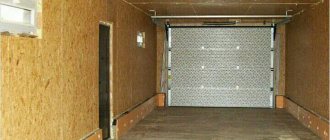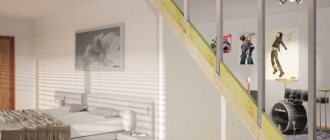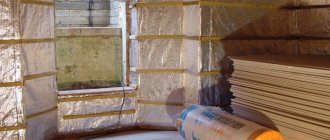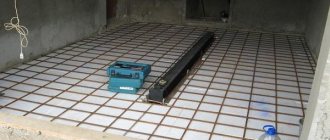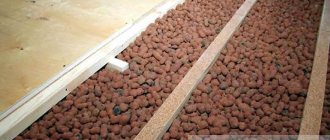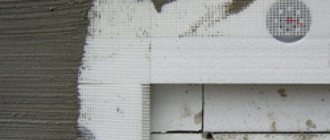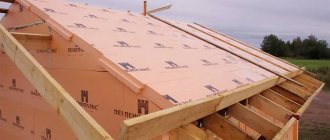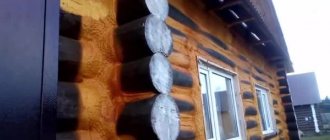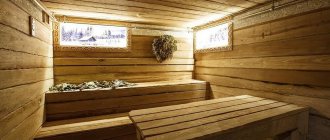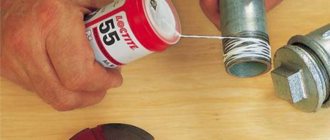Insulating a garage is a process that worries many owners of this small building today. Everyone began to understand that a car lasts much longer in a warm room. Therefore, in this article we will talk about insulation methods, how to insulate a garage from the inside and outside, and what aspects of the insulation process should be paid attention to first.
Insulated garage from the inside, lined with OSB slabs Source roomester.ru
The importance of climate in the garage
Creating optimal conditions in the garage is of great importance.
For example, if it is extremely cold and the surfaces are not insulated, the gate may become covered with a large layer of frost. To improve conditions, it is necessary to insulate walls and gates, and not close the ventilation. After all, it is thanks to the ventilation holes that excess moisture leaves the room, preventing the formation of condensation and metal corrosion. Experts note that it is advisable to maintain a temperature in the garage of at least five degrees Celsius. At the same time, ventilation must also be ensured.
Ventilation
It can be cold inside the garage not because of heat loss, but because of air flow. In this case, insulation will not have an effect, since there will be no “thermos” from the room. Blowing through walls occurs due to leaks, cracks, voids in the seams between bricks or aerated concrete, due to improper connection of door frames and gates. To eliminate these shortcomings, you can use polyurethane foam or plaster.
When looking for the source of a draft, garage owners often seal the vents. This results in condensate not being removed from the room. Dampness eventually leads to mold on the walls and damage to the car.
Advantages and indications for garage insulation
According to the regulations, it is optimal to maintain an air temperature of at least +5°C in a facility for car storage and repair. It is important to ensure proper operation of the ventilation system. With proper air circulation, excess moisture is removed from the room, reducing the risk of condensation, which can lead to metal corrosion.
Advantages of garage insulation:
- the wall, ceiling, gate, roof are the key areas of the insulated object, their careful design helps maintain a microclimate favorable for cars in the allocated space, regardless of the weather conditions outside;
- with the help of competent thermal insulation work, it is easy to optimize the cost of heating a building, protect your transport and equipment from damage by corrosion;
- the functionality of the room increases, since in an insulated building it is possible to organize a storage area not only for vehicles and spare parts for them, but also for furniture and conservation supplies for the winter;
- the comfort of car maintenance is improved;
- In winter, in an insulated garage, the time for warming up the car is reduced and fuel consumption is reduced;
- with high-quality installation of insulation, taking into account the structural features, the risk of freezing of concrete and brick walls is prevented, the formation of mold and mildew is eliminated, and the operational potential of the structure is increased.
Among the advantages of insulating a garage with polystyrene foam is that the time for warming up a car is reduced.
Thermal protection is necessary for garages of any category, including brick, metal, combined buildings and individual ones. You should not limit yourself to insulating the walls and gates of the structure, or neglect the insulation of the roof and floor. To guarantee the effectiveness of thermal protection, an integrated approach is important.
Dense buildings
How to insulate a garage with your own hands? Often garages are installed close together. The side walls seem to be inaccessible for insulation. But there is a way out.
Offer your neighbors on the right and left a non-standard solution: limit the space between the walls and fill it with expanded clay along the entire height to the roof. It is best to weld the openings with steel sheets; a wooden shield is short-lived.
Expanded clay is an excellent insulation material. There is no need to cover the backfill from rain and snow. Expanded clay “breathes”; moisture trapped in the backfill will quickly evaporate. All you have to do is insulate the back wall, gate and roof.
Primary requirements
Insulation of the garage should be carried out taking into account the following requirements:
- Do not block the ventilation openings.
- Measures aimed at protecting against heat loss should involve the use of special materials not only on the walls, but also on the roof and floor of the room.
- Garage doors must close hermetically, and for reliable protection against the penetration of cold, the metal surface of these elements should be covered with heat-insulating materials.
Important! Before you begin insulating a private garage from the inside with your own hands, it would be useful to study SNiP 2.07.01 - 89. The sixth section of this document outlines the basic rules for vehicle storage premises.
Rescue ventilation
The first step to defeating condensation and corrosion is installing ventilation in the garage. In opposite corners of the garage, two pipes must be brought out.
We will place the lower edge of one of them closer to the floor. Cold air will flow into the room through this pipe . A short pipe near the ceiling in the other corner will serve as a hood.
This simple but reliable device will work reliably automatically , without fancy fans, creating natural movement (convection) of air throughout the garage.
Convection will prevent condensation from forming. Wet fumes will simply fly out into the chimney. Exhaust gases hazardous to health, evaporation of fuel, and other chemicals stored in the garage will also be sent there.
Now let’s move on to the most important thing - insulating the garage with our own hands. Here the situation is more complicated, but the task is quite accessible for independent solution.
Basic tips for insulating a garage
When insulating a garage, it is not recommended to skimp on the quality of the material. It is better to buy dense insulation: the higher this indicator, the better the material retains heat.
The most effective heat insulator is high-density polystyrene foam 35 kg/cub.m - PPT-35 and PPT-35N (N - for external use). When choosing insulation, it is important to correctly calculate the costs and take into account additional costs. To work with polystyrene, you only need fastening materials and a standard set of tools. The use of other thermal insulation materials - stone wool, polyurethane foam spraying, foam insulation - will require additional costs for the purchase of waterproofing and vapor barrier films, sprayers, and sometimes payment for the services of third-party organizations.
Pros and cons of different types of insulation
To insulate a garage, you can use any known insulation materials: mineral wool, polystyrene foam, penoplex, penoizol. It is easier to choose a material after becoming familiar with the advantages and disadvantages of different insulation materials and weighing the main pros and cons of the product.
Mineral (stone wool)
Mineral wool is made from stone fiber glued with synthetic resins and is produced in slabs and rolls. This is a popular type of insulation. Mineral wool is environmentally friendly, non-flammable, and inexpensive. Among the disadvantages is low moisture resistance - cotton wool is hygroscopic, and when moistened, its thermal insulation properties decrease. Therefore, the mineral wool heat insulator needs protection: a vapor barrier film is laid on top of it on the room side, and a waterproofing membrane is placed on the wall side.
Foam plastic (expanded polystyrene)
A large number of car owners insulate their garages with foam plastic. The material has many advantages:
- Light weight. The material is lightweight, does not weigh down building structures, and is easy to work with.
- Ease of processing. The foam sheets are cut with a regular knife (hacksaw, jigsaw) and glued onto liquid nails or polyurethane foam.
- Low price. There are no insulation materials on the market cheaper than expanded polystyrene.
- Low thermal conductivity coefficient. The material perfectly cuts off the cold, remaining warm to the touch.
- Non-vapor permeability. In non-residential premises, this parameter is considered a basic advantage - the material does not absorb moisture.
- When wet, the material does not lose its properties. Foamed polystyrene in a garage retains its thermal insulation properties for a long time. Additional procedures for thermal insulation of structures will not be needed for many years.
Among the disadvantages of polystyrene foam is its low strength. The issue of sheet strength is solved by purchasing more rigid high-density polystyrene foam - from 35 kg / cubic meter. m.
Extruded polystyrene foam (penoplex)
The properties of penoplex are similar to polystyrene foam - it is a lightweight porous insulation material with a high thermal insulation coefficient, non-vapor permeable, and moisture resistant. The density of extruded polystyrene foam is higher and it is more expensive than traditional polystyrene foam. The material can be easily cut with a knife, and can be attached to any building structure using liquid nails or umbrella dowels.
Polyurethane foam PPU
Polyurethane foam insulation is called liquid spraying. Its advantage is that the sprayed liquid has good adhesion (adhesion) to different surfaces: polyurethane foam can be applied to metal, brick, timber, plastic, gas blocks, foam blocks, it sticks to a polymer film. Sprayed thermal insulation penetrates into hard-to-reach places and insulates building structures of complex shapes. The disadvantage of the material is that complex mixing and spraying installations are used to apply polyurethane foam. The prices for the services of companies operating in this area are high.
Styrofoam
This material is very popular due to its low cost and ease of installation. It retains heat well and lasts for decades. You can install it yourself, without having any special tools or special construction skills at hand. But it still cannot be called an ideal solution. Although not as significant as mineral wool, it absorbs moisture. Very easily damaged and crumbles. Its granules have low adhesive strength, so over the years they can fly out even with accidental pressure on the material.
But that’s not even the main thing. There is a huge amount of uncertified polystyrene foam in the market due to the high demand for it. Finding a high-quality and safe product for health is not an easy task. And the one that was produced in violation of technology, when the temperature rises and the sun’s rays hit it, it begins to release toxic substances. Considering that the garage is a closed space, this is fraught with serious health problems for the car owner.
Requirements for protecting a garage from low temperature
Garages are primarily built from cinder block, brick, and sometimes ironwork. The thickness of walls made of cinder block or brick is most often in the range of 120-250 mm. They practically do not protect the room from low temperatures, so for comfortable work they need to be reliably insulated.
When insulating a garage internally, you do not need to seal all the holes - this will not improve thermal insulation, but may cause certain problems . Without constant ventilation, moisture from the air will condense on the metal and it will begin to rust. Ventilation also prevents harmful gases from accumulating in the garage.
Condensation is the cause of corrosion
Having carefully rolled the car into the garage, you snap the lock on the gate and happily head home through the snow crunching in the cold.
Meanwhile, you have just personally created all the conditions for the favorable development of corrosion on the car body.
The hot metal of the engine and the hot exhaust pipe will heat the icy air in the garage. But the opposition between heat and cold will be unequal. The engine will cool down quickly.
According to the inexorable laws of nature, drops of condensation will appear on the cooled surface. Corrosion takes over.
But condensation does not only form on the car. Treacherous drops will also appear on the ceiling and walls.
If the garage is metal , it is doomed to rust along with the car.
On brick walls, dampness will eventually cause destructive mold, and fungus .
Oddly enough, cars left in open parking lots in winter are not subject to external condensation. But the condensation process occurs in a closed cabin; these cars rust from the inside . That is why it is recommended to close the windows loosely, leaving slits for ventilation.
This is not safe on the street, but always do this the garage
Choice of insulation
Choosing the best material for insulating a garage is a responsible matter. There are many materials for insulation: sawdust, mineral wool, glass wool, polystyrene foam and others.
You can choose any option you like, but this article will look at insulation using foam plastic as an example (except for the floor). It does not allow moisture to pass through, gives the room good thermal insulation, does not rot, is easy to install and has an affordable price.
Of course, there are also disadvantages, including poor breathability and flammability. But you can purchase special foam treated with fire retardant. Such expanded polystyrene stops burning immediately after the source of fire is eliminated.
Garage thermal insulation materials
Almost any heat-insulating material that meets the following characteristics is suitable for insulating garage walls:
- Not exposed to moisture and fungus;
- Has low thermal conductivity;
- Fire resistant;
- Has little weight;
- Has a positive attitude towards temperature changes;
Which material has good thermal insulation and meets all requirements:
- Styrofoam;
- Glass wool or mineral wool;
- Sprayed polystyrene foam;
It cannot be said that this or that material is better suited for insulating a garage. Each of them has its own specifics, advantages and disadvantages.
Insulating garage walls with mineral wool
Brick walls in the garage are insulated with mineral wool
Mineral wool is one of the most common materials for thermal insulation of a room. Advantages and disadvantages:
- Mineral wool has excellent characteristics;
- Has good sound insulation;
- Low weight of insulation;
- Easy to install;
- The material is resistant to attacks by dampness and fungus, since air has the ability to circulate through the insulation layer.
Disadvantages of the material:
- When wet, cotton wool loses its thermal insulation properties;
- Requires good waterproofing;
- The cost is several times higher than other thermal insulation materials;
Mineral wool is produced in rolls and has a foil-coated heat-generating layer. It will be an excellent solution for insulating walls in a garage.
Disadvantages include a high flammability class and fear of water.
Insulating a garage using polystyrene foam
Polystyrene foam is a cheap and practical material for insulation, easy to use.
Quite cheap, but effective and versatile material. Suitable for insulating all parts of the visit. It is quickly installed, insulating the garage from the inside will take no more than 1-2 days. The advantages include:
- Durability and affordability;
- It is not attacked by mold and does not rot;
- Excellent moisture tolerance;
- Resistant to temperature changes;
Disadvantages of the material:
- Subject to attacks by rodents;
- Under the influence of sunlight, the foam begins to lose its structure;
- Flammable quickly;
It is worth emphasizing that insulating a garage with foam plastic from the inside requires additional finishing with plaster or concreting
Spray polyurethane foam
Garage walls are treated with sprayed polyurethane foam
Polyurethane foam entered the market not so long ago, but already from the first sales it gained leadership in its field. There are no questions regarding the insulating qualities, but the price of the material is too high. The principle of operation is to spray a protective layer that is completely sealed and resistant to physical and chemical influences. Polyurethane foam, as insulation for the inside of a garage, is ideal armor against frost and moisture.
It is important to know! Before insulating a brick garage from the inside, it is necessary to study the design of the roof and floor covering. Based on the information received, the choice of insulation is made.
Warm plaster
A brick garage is often insulated with special heat-insulating plaster
Quite a modern material that looks like ordinary plaster. The composition contains substances with low thermal conductivity, namely:
- Expanded clay;
- Expanded polystyrene;
- Pumice;
- Sawdust;
- Vermiculite;
Polystyrene plaster performed best. The material is used both outside and inside. The price is of course high, but it is due to the best thermal insulation performance.
Warm plaster is still best used in combination with other types of thermal insulation
Working with this type of insulation is quite simple, so insulating the garage from the inside is done with your own hands.
Sawdust-based plaster is also considered quite popular. It also has excellent thermal insulation properties and can be used inside and outside. The disadvantages of such plaster include the drying time. To make the process go faster, the room must have good ventilation.
Advantages of warm plaster
The main advantage is the speed of installation. If to install other insulating materials, you initially need to prepare the walls for their fixation, then with plaster everything is different. The surface does not need to be leveled; the plaster adheres perfectly to any material. There is no need to use reinforced mesh or anything else.
Of course, compared to traditional insulation materials, plaster is significantly inferior in its characteristics. Its use alone may not be enough for good thermal insulation of the room. Therefore, this material is best used in combination with other insulation materials.
Thermal insulation paint
One of the easiest materials to use. It also appeared on the market not so long ago, but in a short period of time it was able to gain customer trust. Despite its simplicity, the paint is highly effective in thermal insulation of a room.
In the photo a layer of heat-insulating paint is applied
In terms of properties, a layer of paint is 5 mm, but in terms of efficiency they replace 1.5 meters of a brick wall. Therefore, when choosing heat-insulating paint to insulate the walls of the garage, the owner will not go wrong. The unique composition of the insulation is based on the structural features and principle of operation. If other insulation simply does not allow heat to pass through itself, then thermal paint also serves as a reflector. The material has similar properties due to the vacuum that is inside the paint.
Advantages of thermal insulation paints
They have excellent thermal insulation characteristics and are not susceptible to attacks by fungus and moisture. Excellent attachment to unprepared surfaces. When using such insulation, the structure is not overloaded, since the paint layer has little weight. The paint is fire-resistant; at high temperatures it does not ignite and simply smolders.
The only disadvantage is the cost of the material, but the price is fully due to many advantages.
What tools will you need?
Of course, the list of tools directly depends on the material that will be used for insulation, but most likely you will need: nails, a hammer, a drill or hammer drill, a screwdriver, a saw or a grinder, and so on.
Electric heating
Electric heating is a simple and effective option. Does not require arrangement of a water circuit. But electricity must be supplied to the garage (in cooperatives and private houses there are no problems with this, but if the box is located in the courtyard of an apartment building and initially there is no power supplied to it, then there will be problems with this).
Fan heaters
A household fan heater is a device consisting of a heater and a fan that blows out heated air. There are two types:
- With a spiral as a heating element. Such fan heaters are cheaper, less reliable, and burn oxygen. Their operation requires normal ventilation and air exchange. The average cost is from 600 rubles.
- With ceramic heater. A modernized version of the previous ones, they do not burn oxygen, are durable, and do not heat up to the point of incandescence (therefore, the ignition of flammable materials is unlikely). But they are more expensive and their efficiency is lower than that of fan heaters with a spiral as a heating element (by 10 - 20%). The average cost is from 800 rubles.
A fan heater is an electric heater with a fan that blows out heated air and thus cools the heating element. There are models with remote control, automatic thermostat, power regulator
Which fan heater is suitable for heating? You should focus only on power consumption. The optimal option is from 2000 Wh. This is capable of raising the temperature by 5 - 8 degrees in a box with an area of 15 - 20 m² within 30 minutes after switching on.
Ceramic heaters are 10 - 20% more expensive than those that use a spiral as a heating element. But they are better for boxing, that’s why they are preferred
Infrared heaters
Infrared heaters are no less efficient than fan heaters, but consume much less electricity. Their difference is that they do not heat the air, but only emit infrared rays, which heat the surface they hit. The average price of an 800 W heater (optimal performance, it makes no sense to buy with less power) is 2800 rubles and more.
Prices for fan heaters
fan heater
Infrared heater. It does not heat up during operation, so it can be placed even close to flammable materials. This is an economical option for heating non-residential premises, but is not suitable for a garage
Convector
The oil convector turns out to be the most effective among all other variations of electric heaters. They consume a lot of electricity, but do not make any noise, and are relatively safe (they heat up to only 70 - 80 degrees, so even flammable materials are unlikely to ignite). There are also wall-mounted variations of oil convectors that take up minimal space. If you need to save money, but it is impossible to equip full heating using solid fuel, then convectors are the best choice.
The average price is from 2000 thousand rubles. It is recommended to use models with a power of 2000 Wh and above. It is better to choose models with a built-in thermostat or thermostat (they automatically turn off when the set temperature is reached). If you heat the room to only 15 degrees, the final electricity consumption will be small compared to conventional heaters.
Floor convector
Heated floor system
The option is economical, but the heating cables themselves are not cheap. In addition, you will need to use those that are allowed to be installed in rooms with an aggressive environment (fuel oil, gasoline, oil, solvents, antifreeze - all these substances damage the insulation of conventional cables). But a heated floor system can only be installed if the following conditions are met:
- the heated floor is covered from above with a screed or other flooring material (that will support the weight of the car);
- the heating circuit is laid evenly throughout the room (except for the pit, if there is one); installing it, for example, only around the perimeter will be ineffective.
But such a heating system consumes the least amount of electricity. When using heaters, all the warm air accumulates under the ceiling, while the heated floor ensures uniform heating of the entire internal volume of the box. And if the heating cables are hidden under the screed with a layer of 10 cm or more, then even after turning off the heating the room will be warm for at least 2 - 3 hours (while the heated floor cools down).
A prerequisite is that the underfloor heating system must be laid on a thoroughly insulated base, otherwise the heat will be spent extremely inefficiently
How to insulate correctly?
In what order to do this is, of course, up to you. The main thing is not to ignore all areas and follow a simple algorithm of actions.
Gates
Many people ignore this part of the garage - and completely in vain, because the maximum amount of heat escapes through the metal gates. Foam sheets are best suited to solve the problem. The operating procedure will be as follows:
- do the sheathing first;
- use dowels or waterproof glue to secure the foam sheets to it;
- seal all cracks with polyurethane foam;
- level the resulting surface with putty;
- All that remains is the finishing touch - for example, paint.
Experts also recommend that after all this, make a so-called thermal curtain - hang thick fabric over the entire height of the gate.
Ceiling
To prevent the warm air rising from evaporating, polystyrene foam will again help. The operating procedure depends on the type of ceiling:
- if there is a concrete base, then first make a frame and only then attach foam plastic to it;
- if the ceiling is wooden, then you can safely skip creating the sheathing and attach the insulation directly to the base, even with simple nails.
In any case, after that you need to go over the joints with polyurethane foam and carefully seal everything. To enhance aesthetics, it is recommended to carry out at least minimal finishing. Which one? It's up to you to decide.
How to make your own garage insulation
Even if you do not have the necessary skills, performing garage insulation work will not cause any difficulties. Next, the processes of insulating the floor, roof and walls of a garage will be discussed step by step.
Floor insulation
Dense types of foam plastic are ideal for floor insulation. The work is carried out as follows:
- The top layer of soil is removed to a depth of 10 cm.
- The exposed layer of soil is carefully compacted.
- A rough layer of screed about 5 cm high is poured into the recess.
- When the concrete solution has hardened, a layer of waterproofing is laid on it (you can use roofing felt, which is laid in an overlap).
- Penoplex is laid on the waterproofing, which is glued with special glue at the joints.
- A layer of waterproofing is again pricked on top of the foam sheets (ordinary polyethylene film is ideal for this purpose).
- Reinforcing mesh is laid.
- The concrete solution is poured at the level of the previously placed beacons.
When the cement-sand mixture hardens, the process of insulating the garage floor can be considered complete, but it is recommended to place the car in the garage no earlier than the concrete has reached its original strength.
Ceiling insulation
Figuring out how to insulate a garage ceiling is also not difficult. In addition to the materials listed above, you can also use mineral wool for this purpose. The simplest option, as with floor insulation, is the use of foam boards.
Insulation of the ceiling in the garage should be carried out only after careful preparation of the surface. If this procedure is ignored, then the reliability of fastening the insulation will be in question. Remains of finishing materials (if any) are removed from the surface, and any contaminants are also removed.
When the prepared surface is completely dry, begin laying the foam. To securely fasten the boards, a special glue is used, which must be applied pointwise to the surface and to the material itself. The cracks at the joints of the insulation should also be sealed with adhesive or polyurethane foam.
Having figured out how to insulate the ceiling in a private garage and completed this work, you can begin to insulate vertical surfaces.
Wall insulation
If the floor and ceiling were insulated with foam plastic, then the walls can be reliably insulated from the cold using this material. Insulation of the walls of a private garage can also be done using adhesive materials, but if you want to make a more reliable structure, timber sheathing is attached to the walls. The wooden material is pre-treated with an antiseptic and fire retardant in order to extend the service life of the structure. It is recommended to place the beam in a vertical position, and the distance between the frame elements should be equal to the width of the foam sheet.
If the distance between the frame elements has been correctly selected, then the insulation can be installed without additional fixation, but for greater reliability, it is also recommended to coat the slabs with liquid nails.
Installing protective coating on walls
As a rule, when insulating a garage from the inside, mineral wool and foam panels are used. Their installation is carried out according to the same scheme.
Preparatory work
The surface is cleaned of old cladding, dust and dirt. The paint is removed with a spatula and sandpaper. Oil and gasoline stains are cleaned with a rag and an alcohol solution. Moisture is removed using radiators or a hair dryer. The cracks are plastered, sealed with sealant and putty. Then treatment is carried out with an antiseptic and a strengthening primer.
External waterproofing
It is necessary to protect the porous structure from moisture coming from outside. Moisture falls out in the form of condensation and seeps through cracks. Polyethylene-based films are used as waterproofing. Some of them have voids filled with air.
Foamed polyethylene is produced in the form of a sheet with a thickness of 2 to 10 mm. It transmits temperature worse than mineral wool and provides a high level of sound absorption. The canvases are laid with an overlap of 10 cm. They can have a foil coating on one or both sides. The rolls are cut with a carpenter's knife and glued or sewn with thin nails. The joints are sealed with tape.
Installation of a wooden frame
In terms of strength, it is not inferior to metal, but it does not create cold bridges. The size of the parts and the distance between them depend on the height of the panels. Use timber with a rectangular cross-section. The species and type of wood do not matter. If there are cracks, falling knots, or mold stains, the parts are rejected. The sheathing consists of parallel vertical beams secured with screws and dowels. Before use, the workpieces are dried, treated with an antiseptic and coated with a layer of varnish.
To get rid of cold bridges, the frame should be mounted on a counter-lattice - then the screws will not come into direct contact with the enclosing structures. The counter-lattice is assembled from slats, the height of which allows the main frame to be attached to them. They are fixed along the entire length. When insulating a metal garage with thin walls, it is more convenient to screw in screws from the street side.
Laying panels in cells
Products with closed pores are mounted on glue. These include jacketed mineral wool boards and expanded polystyrene. This method provides the most effective protection. The slabs must fit tightly to the beams. You cannot leave gaps - the cold from the street will penetrate through them. Panels with open voids are mounted using dowels with wide heads. Thanks to this device, they do not fall into the loose structure and hold it in the desired position. To reduce heat loss, use plastic dowels and caps.
A loose, unshaped mass of mineral fiber is placed in rectangular cells. To do this, horizontal jumpers are nailed to the vertical elements, serving as shelves. Without them, the material will fall down.
Internal waterproofing
It is needed to ensure that the steam in the room does not penetrate the pores.
The film is mounted on a wooden frame with a stapler or laid with glue. Instead of polyethylene, you can install a “breathable” membrane that traps steam from the outside but allows air to pass through. It is attached like a regular film.
Before finishing, the surface is covered with plasterboard sheets and puttied.
Prefabricated metal structures with different cladding
The disadvantages of a metal garage are cold and high humidity. Building a garage from ready-made sheets using a frame is quick and convenient. Using a welded metal frame, you can install two wall options:
- Sandwich panels are slabs of two profiled metal sheets with a layer of insulation inside.
- Corrugated sheeting - only PS or C markings are suitable for walls. Sheet hardness is at least 20. For a light and durable structure, you need C-20 corrugated sheeting.
Solid concrete blocks or concrete slabs are suitable as a foundation for such a prefabricated structure. Some craftsmen are sure that there are simply no more reliable slabs than a poured slab monolithic foundation, 50 cm deep.
The frame posts are concreted into the foundation. It is imperative to provide a blind area up to 20 cm wide.
Sheets of corrugated sheets or sandwich panels are installed over the installed and welded frame using screws, rivets or bolts.
Preparing the work surface
Do you have a brick garage? Then polystyrene foam will fit just perfectly. It will prevent weathering of the seams, extend the life of the walls, improve sound insulation and minimize heat loss. For garage spaces made from other building materials, foam is also perfect.
Before insulation, all working surfaces must be prepared. Walls, ceilings, gates must be cleaned of dust, dirt, and old plaster. The base under the insulation layer must be clean and durable. Then the foam will be able to be fixed well. All cracks and chips must be covered with a layer of plaster to achieve a smooth surface.
We install polystyrene foam
When insulating garage walls from the inside with polystyrene foam, it is important to pay special attention to the installation of the material. The thermal insulation properties, as well as the service life of the coating, will largely depend on this.
When walls made of concrete or brick are insulated, 25-density foam plastic with a thickness of 10 cm is usually used. Two layers of 5 cm can be applied. Longitudinal and transverse seams are tied.
Here is an approximate working algorithm. If necessary, it can be slightly changed and improved.
- Pre-prime the surface to improve adhesion to the adhesive.
- Apply glue in medium-sized “blobs”. You can use a notched trowel.
- The sheets are pressed tightly enough.
- Cover the wall from bottom to top.
- Lay the insulation sheets in a checkerboard pattern.
- Use strips secured with dowels to the surface.
- The masonry elements are additionally secured with plastic dowels when the adhesive composition has completely hardened.
In general, installation is quite simple. The main thing is to be careful and do everything more carefully so that the insulation layer is continuous.
Video description
In order not to go into details of the technological process, we suggest watching a video that explains how to properly apply warm plaster to walls in two ways:
Expanded polystyrene boards for external insulation
If the garage is built from bricks or blocks, then polystyrene foam boards can simply be attached to the wall surfaces, laying them tightly together. There are two mounting methods:
- on mushroom-shaped screws or, more precisely, on dowel-nails for insulating materials;
- on the adhesive composition.
Usually the first one is used, because glue for polystyrene foam is an expensive thing. It is sold in cans. The contents are applied to the back of the slab in the corners and in the middle. And then they just press him to the wall.
As for self-tapping screws, these are special plastic fasteners consisting of two parts: a dowel and a nail. Under the first one, a hole is made through the insulation in the wall into which the dowel is inserted. At the same time, its wide cap will hold the insulating board. After which the second part is hammered into it, which bursts open the first.
Dowel nail for insulation boards Source de.decorexpro.com
Typically, two fasteners are used for each slab. When laying thermal insulation, it is very important to ensure that there are no gaps or cracks between its elements. It is optimal to use slabs with a tongue-and-groove connection for this purpose. If ordinary slabs with smooth edges are used, then when gaps form between them, the latter are filled with special foam. It is similar to the assembly one, only it does not expand in volume when exposed to air.
How polystyrene foam boards are attached to the wall with mushroom-shaped nails Source stroyfora.ru
How to insulate a brick garage from the inside with your own hands
Here is a short algorithm of actions:
- Clear the walls.
- Mount the frame.
- Carry out waterproofing using special mixtures or film coating.
- Install the frame with such a step that the width of the step is a couple of centimeters smaller than the heat insulation sheet.
- Cover the frame with clapboard or plasterboard.
Garage roof insulation
The roof of the garage must also be insulated. Unfortunately, many car enthusiasts forget about this. They prefer to make a kind of box out of thermal insulation material, and leave the roof without attention. As a result, the required temperature regime can no longer be achieved.
Here are some useful tips.
- If you are insulating the ceiling in a garage using foam plastic, you should not drill holes for the bars. It's better to use glue.
- When the roof consists of reinforced concrete slabs, it is advisable to take care of external and internal insulation.
- If you apply foam plastic from the outside, you will have to additionally make a plaster screed. The optimal solution is to lay a waterproofing layer between the insulation and the plaster. You can use roofing felt or film.
- Is the sheathing loose? Then fix the layers of insulation between the rafters. After this, you can use a waterproofing film.
- Do you have a continuous sheathing or a good rafter system? In this case, waterproofing is laid on top, and the insulation is fixed under the sheathing.
- Waterproofing film requires careful attention. Make sure that it does not come into direct contact with the insulating layer if it has reduced vapor permeability.
The best scheme for insulating a garage roof is: waterproofing - thermal insulation - vapor barrier.
Conclusion
Of course, looking at various photos of a high-quality insulated garage, everyone wants to reproduce such a decent finish in their own home. And this is quite real, there is nothing complicated about it.
Any “straight-handed” person is able to do everything himself without much expense or effort. It won’t take too much time, but there will be a huge amount of benefits. The car will be protected from the influence of an aggressive external environment, and its owner will be able to comfortably carry out car repairs during the cold season.
Sources
- https://garazhov.ru/inside/uteplenie-garazha-penoplastom.html
- https://pechiexpert.ru/uteplenie-garazha-penoplastom-01/
- https://www.tproekt.com/kak-uteplit-garazh-iznutri/
- https://www.plast.by/novosti/utepleniye-garazha.html
- https://garazhmechti.ru/kommunikacii/kak-uteplit-garazh-iznutri-deshevo.html
- https://mirstrojka.ru/uteplenie-garazha/
- https://uteplenieplus.ru/kak-uteplit/garazh/kirpichniy-garazh-iznutri/
- https://bibiauto.club/sovets/poleznoe/uteplenie-garazha-iznutri.html
- https://garazhmechty.ru/kak-pravilno-uteplit-garazh.html
- https://www.ivd.ru/dizajn-i-dekor/zagorodnyj-dom/vse-o-samostoyatelnom-uteplenii-garazha-iznutri-56901
[collapse]
